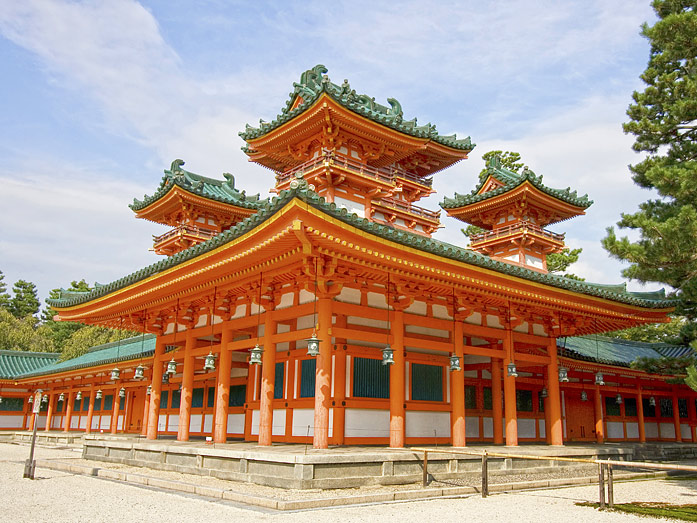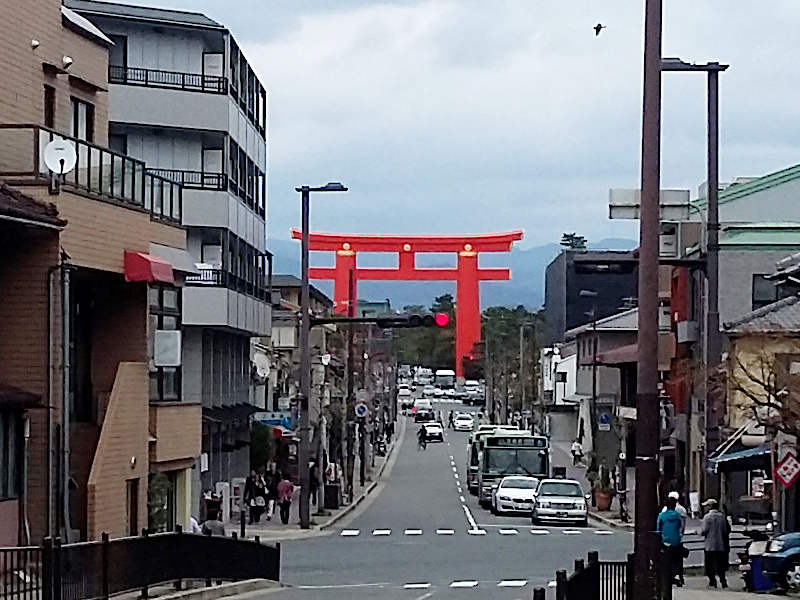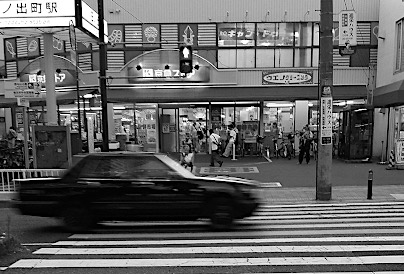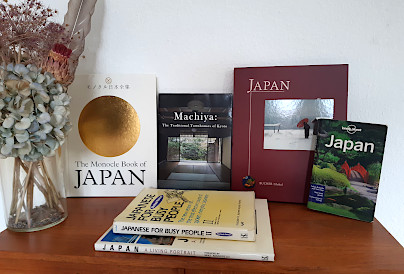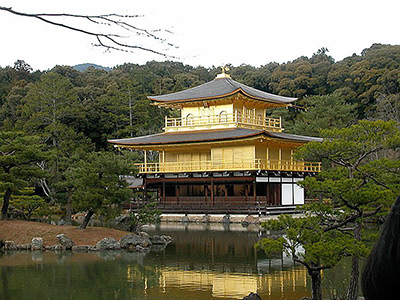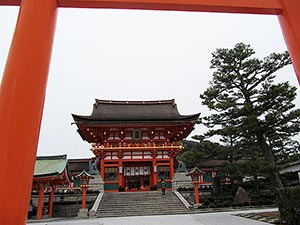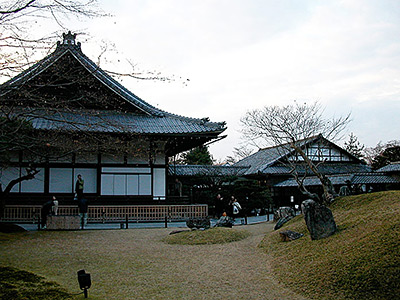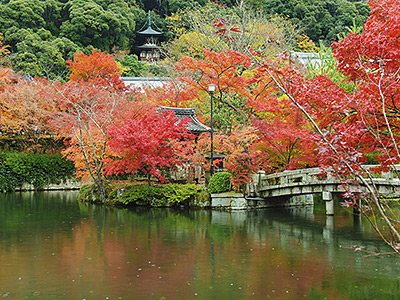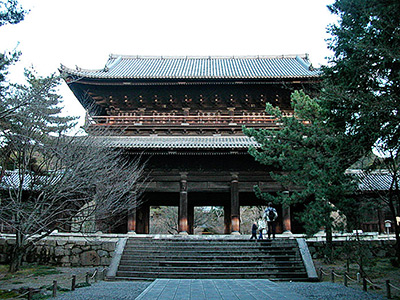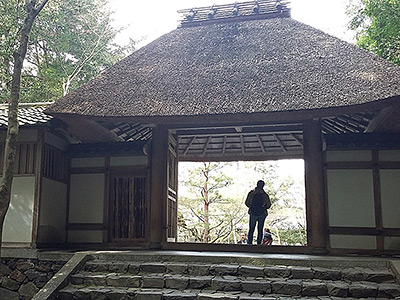Heian Jingu Shrine in Kyoto
This post can contain affiliate links, which means that we may receive a small commission if you make a purchase using these links.
Facts & Figures
Heian Shrine (Heian-jingu) is an outstanding Shinto Shrine in Kyoto and an important cultural property of Japan. The entrance gate (torii) of the shrine is with a height of 24,2 meters one of the largest in Japan and the impressive beams are 3,63 meters in diameter. In some parts the Heian Shrine is a replica of the Heian Palace (destroyed by a major fire in 1177). The honden (main shrine) is a 5:8 scale reduction of the original building. The shrine complex includes four landscape gardens, which cover an area of appr. 30000 square meters. The shrine buildings surrounding a huge gravelled courtyard. The best time for a visit is the cherry blossom season in Kyoto (mid April). Heian Jingu is also a very popular place for traditional Japanese weddings and believe it or not modern pop concerts.
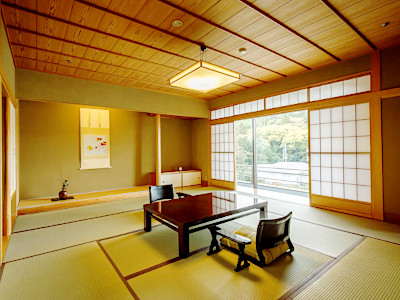 Explore Ryokans in Kyoto >
Explore Ryokans in Kyoto >
Ryokans are the perfect way to discover old Japanese culture and traditions.
- Heian Shrine:
- Opening Hours - 6:00 am to 5:30 pm or 6:00 pm (whole year)
- Admission Fee - free
- Heian Shrine Japanese Garden:
- Opening Hours - 8:30 am to 4:30 pm or 5:00 pm (whole year)
- Admission Fee - 600 yen (Adults), 300 yen (Children)
My tips for local activities
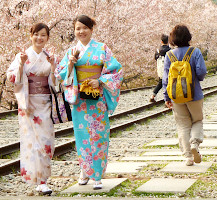
How about exploring the best parts of my favourite city Kyoto with a local guide? The personalized tour by our partner GetYourGuide can take between 2 - 8 hours. For more details check out this page >
History
The Heian Jingu Shrine was built in 1895 to celebrate the 1100th anniversary of the establishment of Heian-kyo (former name of Kyoto) as the capital of Japan from 794 to 1868. The shrine honours the first and last ruling emperors (Kammu 737-806, Komei 1831-1866) from Kyoto. Later the capital was moved to Tokyo. The four Heian Jingu gardens were made between 1895 and 1981. Each of the gardens represents a different time period within the history of Japan: Heian (794-1185), Kamakura (1185-1333), Momoyama (1568-1603) and Edo (1603-1867).
Location

Heian Shrine is located north of central Kyoto.
Address: Nishi Ten-o-cho, Okazaki, Sakyo-ku, Kyoto
How to get to Heian Shrine?
- 30min from Kyoto St. by Kyoto City Bus nr. 5 or 100 to Kaikan Bijitusu-kan Mae Stop or
- 20min from Karasuma Oike Subway Station to Higashiyama Station and
- 10min walk to the Heian Shrine
Sightseeing spots
Top:
Main Building (honden) - in parts a replica (in a smaller scale) of the Imperial Palace from the Heian Period (794 - 1185)
Heian Jingu gardens - The four gardens located behind the main building are a National Site of Scenic Beauty. It took gardener Jihei Ogawa 7th (also known as Ueji) over 20 years to complete 3 out of 4 gardens. In 1895 he completed the West and Middle Garden and in 1916 the East Garden. His masterpiece is the huge central pond (seiho-ike), which gets its water supply from the Lake Biwa Canal. In 1981 the South Garden was added.
Oten-mon - the vermillion painted 2-story main entrance gate of Heian Jingu features unique blue tiles at the roof
Byakko-ro (White Tiger) and Soryu-ro (Blue Dragon) - these two Chinese-style towers can be found right behind the Oten-mon gate
Daigokuden - the outer hall of worship uses the similar architecture style of the Oten-mon Gate
Festival & Events (dates can change without notice)
February
Setsubun-sai at the Heian-jingu (3rd)
The day before spring starts is used to get rid of evil forces and bad luck and to prepare the family and home for the upcoming year. This cleaning ritual starts at 1pm and last till 4pm at the shrine grounds.
April
Miyako Odori (1st - 31th)
The traditional annual spring dance of the Kyoto district Gion Kobu performed by Geiko and Maiko is a must-see on your Kyoto visit. Don't miss the most popular dances the Miyako Odori "Cherry Blossom Dances" or "Dances of the Old Capital" at the Gion Kobu Kaburenjo Theater (located close to Gion Corner).
Annual Shrine Festival (15th)
The memory of Emperor Kammu will be celebrated with some traditional ceremonies.
May
Aoi Matsuri (15th)
The highlight of this festival is a large parade from Imperial Palace through Shimogamo Shrine to the Kamo Shrines. More than 500 people wearing aristocratic costumes from the Heian Period (794 - 1185). The Aoi Matsuri belongs with the Gion Matsuri and Jidai Matsuri to the three most famous festivals in Kyoto.
Arashiyama Mifune Matsuri (third Sunday of May)
The first part is held at the Kuramazaki Shrine. Later a procession is leading to the Oi River, where more ceremonies and traditional dances (Funa Asobi) are held. The Arashiyama Mifune Matsuri started in 1914.
June
Takigi Noh performances at the Heian-jingu (1st -2nd)
This is one of the oldest forms of Japanese musical theater. Enjoy the open-air stage and the unique atmosphere of ancient times. Important to know: The ticket sale starts in April.
July
Gion Matsuri (whole month)
The month July is full of different events like the Yoiyama - Kyoto's Magical Night (locals in kimonos look at the giant Gion floats the day before the parade) or the famous Yamaboko Junko (float procession on the 17th of July).
October
Jidai Matsuri ("Festival of Ages") (22nd)
People celebrate with a large parade between Imperial Palace to Heian Shrine the anniversary of the foundation of Kyoto. App. 2000 participants wearing historical costumes from different time periods. Enjoy this great festival which last around 2 hours.
Where to stay in Kyoto?
Day trips from Kyoto:
My 100 Best Moments in Japan
I have visited Japan nearly every year since 2004. This is my collection of the 100 best moments in my favorite country. Enjoy the pictures and I hope you will start your own journey soon.
Find out more >
Books about Japan
Reading books is a great source of inspiration for me. Check out my recommended list of books about the fascinating country Japan.
My Book recommendations >


